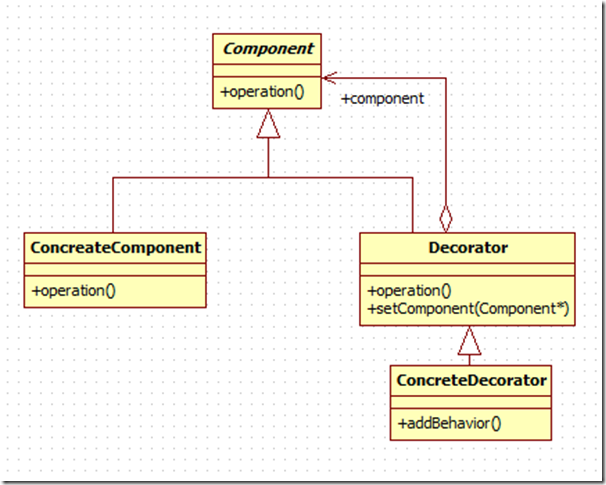装饰者模式
时常会遇到这样一种情况,我已经设计好了一个接口,并且也有几个实现类,但是这时我发现我设计的时候疏忽了,忘记了一些功能,或者后来需求变动要求加入一些功能,最简单的做法就是修改接口,添加函数,然后继承类中都相应的添加实现,这样做倒也没什么问题,但是如果这种变化来个好几次或者继承类非常多,那工作量可就大了。
这时大神们就发明了装饰者模式,在不修改现在有接口和实现类的基础上实现功能或者状态的添加。
从类图上看,ConcreteComponent是Component原有的继承类,而Decorator装饰者类也继承与Component,这样的是让Decorator的子类也可以方便的添加Component,而不用每个子类里面都去包含一次Component。(我的理解)
这样客户端使用的时候只需要知道ConcreteDecorator就可以直接调用Decorator的operation方法了,至于operation方法是怎么实现的以及使用的Component的哪一个子类是不需要关心的,而且添加的方法addBehavior也可以直接使用。
客户端就无法依赖于抽象了,如果addBehavior的实现方法要变了,比较好的是添加新的ConcreteDecorator子类,或者继承这个ConcreteDecorator重新实现addBehavior。
常用的情况
如果需要添加新功能,但又不想修改定义好的接口或者抽象类,那么这时候就比较适合装饰模式,例如很多图形系统中的组件,就可以使用装饰模式,来让新的组件在继承现在功能的基础上添加新的功能。
装饰模式一般是针对接口或者抽象类的变化,如果是具体实现类的变化,则要考虑适用哪种模式。
优点
1.可以不用修改原有的接口,就可以实现新功能的添加。
2.装饰者可以很方便的转换原有接口中的实现,可以给装饰者指定不同的ConcreteComponent实现不同的功能。
缺点
1.复杂性增加,装饰者模式会导致许多小类的产生。
C++代码实现
1 #ifndef _COMPONENT_H_ 2 #define _COMPONENT_H_ 3 4 5 class Component 6 { 7 public: 8 Component(); 9 virtual ~Component(); 10 11 virtual void operation() = 0; 12 }; 13 14 15 class ConcreteComponent: public Component 16 { 17 public: 18 ConcreteComponent(); 19 ~ConcreteComponent(); 20 21 void operation(); 22 }; 23 24 25 #endif
1 #include "Component.h" 2 #include <stdio.h> 3 4 5 6 Component::Component() 7 { 8 9 } 10 11 12 Component::~Component() 13 { 14 15 } 16 17 18 ConcreteComponent::ConcreteComponent() 19 { 20 21 } 22 23 24 25 ConcreteComponent::~ConcreteComponent() 26 { 27 28 } 29 30 31 void ConcreteComponent::operation() 32 { 33 fprintf(stderr, "ConcreteComponent's operation!\n"); 34 }

1 #ifndef _DECORATOR_H_ 2 #define _DECORATOR_H_ 3 4 #include "Component.h" 5 6 class Decorator: public Component 7 { 8 public: 9 Decorator(); 10 virtual ~Decorator(); 11 12 virtual void operation(); 13 virtual void setComponent(Component* pComponent); 14 15 protected: 16 Component* mComponent; 17 }; 18 19 20 class ConcreteDecorator: public Decorator 21 { 22 public: 23 ConcreteDecorator(); 24 virtual ~ConcreteDecorator(); 25 26 virtual void addBehavior(); 27 }; 28 29 30 #endif

1 #include "Decorator.h" 2 #include <stdio.h> 3 4 5 Decorator::Decorator() 6 { 7 8 } 9 10 11 Decorator::~Decorator() 12 { 13 14 } 15 16 17 void Decorator::operation() 18 { 19 mComponent->operation(); 20 } 21 22 23 void Decorator::setComponent(Component* pComponent) 24 { 25 this->mComponent = pComponent; 26 } 27 28 29 ConcreteDecorator::ConcreteDecorator() 30 { 31 32 } 33 34 35 ConcreteDecorator::~ConcreteDecorator() 36 { 37 38 } 39 40 41 42 void ConcreteDecorator::addBehavior() 43 { 44 fprintf(stderr, "ConcreteDecorator's addBehavior!\n"); 45 }

1 #include "Decorator.h" 2 3 4 5 int main() 6 { 7 Component* pComponent = new ConcreteComponent(); 8 ConcreteDecorator* pConDecorator = new ConcreteDecorator(); 9 pConDecorator->setComponent(pComponent); 10 pConDecorator->operation(); 11 pConDecorator->addBehavior(); 12 return 0; 13 }
1 g++ -o client client.cpp Component.cpp Decorator.cpp
运行结果







【推荐】国内首个AI IDE,深度理解中文开发场景,立即下载体验Trae
【推荐】编程新体验,更懂你的AI,立即体验豆包MarsCode编程助手
【推荐】抖音旗下AI助手豆包,你的智能百科全书,全免费不限次数
【推荐】轻量又高性能的 SSH 工具 IShell:AI 加持,快人一步
· 如何编写易于单元测试的代码
· 10年+ .NET Coder 心语,封装的思维:从隐藏、稳定开始理解其本质意义
· .NET Core 中如何实现缓存的预热?
· 从 HTTP 原因短语缺失研究 HTTP/2 和 HTTP/3 的设计差异
· AI与.NET技术实操系列:向量存储与相似性搜索在 .NET 中的实现
· 地球OL攻略 —— 某应届生求职总结
· 周边上新:园子的第一款马克杯温暖上架
· Open-Sora 2.0 重磅开源!
· 提示词工程——AI应用必不可少的技术
· .NET周刊【3月第1期 2025-03-02】